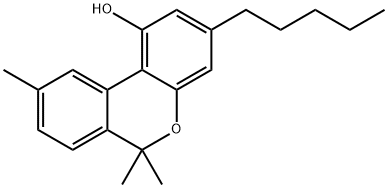CANNABINOL
|
|
CANNABINOL 속성
- 녹는점
- 76-77°
- 끓는 점
- bp0.05 185°
- 밀도
- 1.0865 (rough estimate)
- 굴절률
- 1.4900 (estimate)
- 인화점
- 11 °C
- 저장 조건
- 2-8°C
- 산도 계수 (pKa)
- 9.40±0.40(Predicted)
- 안정성
- 안정적인. 타기 쉬운. 강한 산화제와 호환되지 않습니다.
안전
- 위험 및 안전 성명
- 위험 및 사전주의 사항 (GHS)
| 위험품 표기 | F,T | ||
|---|---|---|---|
| 위험 카페고리 넘버 | 11-23/24/25-39/23/24/25 | ||
| 안전지침서 | 7-16-36/37-45 | ||
| 유엔번호(UN No.) | UN 1230 3/PG 2 | ||
| WGK 독일 | 1 | ||
| RTECS 번호 | HP8575000 |
CANNABINOL C화학적 특성, 용도, 생산
화학적 성질
thin platelets용도
A metabolite of Tetrahydrocannabinol (T293200). A psychoactive substance cannabinoid that acts as a weak agonist of the CB1 and CB2 receptors.일반 설명
Leaflets.반응 프로필
CANNABINOL is an alcohol. Flammable and/or toxic gases are generated by the combination of alcohols with alkali metals, nitrides, and strong reducing agents. They react with oxoacids and carboxylic acids to form esters plus water. Oxidizing agents convert them to aldehydes or ketones. Alcohols exhibit both weak acid and weak base behavior. They may initiate the polymerization of isocyanates and epoxides.화재위험
Flash point data for CANNABINOL are not available, but CANNABINOL is probably combustible.생물학적 활성
CB 1 and CB 1 receptor agonist (K i values are 126 and 211 nM respectively). Inhibits adenylyl cyclase (EC 50 values are 120 and 261 nM for CB 1 and CB 2 receptors respectively) and suppresses immune cell function. Major constituent of cannabis; displays little or no psychotropic activity.Purification Methods
Cannabinol crystallises from pet ether and sublimes in a vacuum. [Meitzer et al. Synthesis 985 1981, Beilstein 17 II 151, 17 III/IV 1652.]CANNABINOL 준비 용품 및 원자재
원자재
준비 용품
CANNABINOL 관련 검색:
오산화 인 DL-설피라이드 1(3H)-아이소벤조퓨란온, 3,3-비스(4-하이드록시페닐) 2-페닐페놀
Phenacetin
HEPARIN CALCIUM
Naloxone
DICHLORALPHENAZONE
CANNABIDIOL
2,5-DIMETHYLRESORCINOL
2-METHOXYBIPHENYL
4-Propylbiphenyl
CANNABINOL
4-N-PENTYLBIPHENYL
4-Butyl-1,1'-biphenyl
3-T-BUTOXYTOLUENE
1-(2,4-DIMETHYLPHENYL)ETHANOL
2,5-DIMETHYLBIPHENYL









